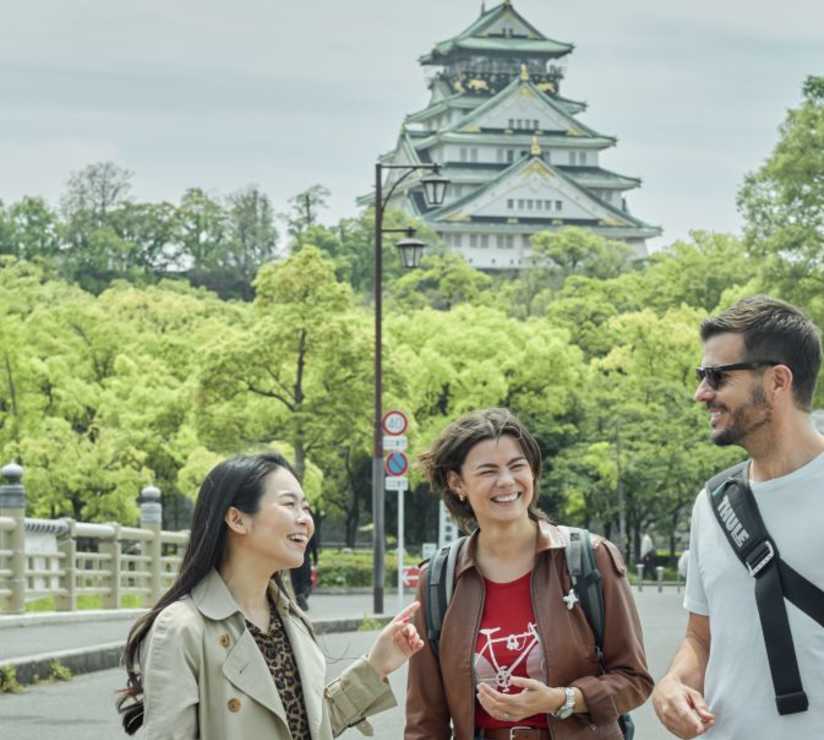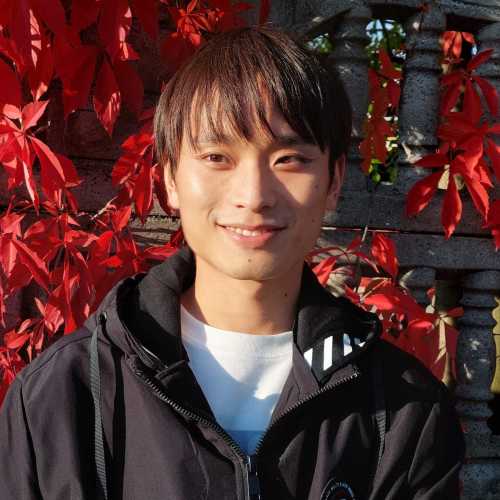Table Of Contents
- "Hidden Gems"
- The Real Story Behind Osaka Castle
- Why Most People Miss the Best Views
- The Universal Studios Japan Reality Check
- Beyond the Postcard: Osaka's Actual Best Kept Secrets
- Food Tours vs. Real Food Culture
- The Day Trip Dilemma: Staying vs. Leaving
- Transportation Reality: Getting Around Like a Local
- Seasonal Osaka: When Timing Changes Everything
- The Museum Question: Culture vs. Experience
- Aquariums and Marine Life: Kaiyukan's Appeal
- Nightlife: Beyond the Neon Lights
- The Spa World Exception
- Creating Your Own Osaka Experience
- What Makes Osaka Worth Multiple Visits
- Final Recommendations: Making the Most of Your Time
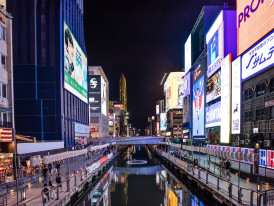
A local walking through the early morning streets of Dotonbori before the crowds arrive, with iconic neon signs reflecting in the canal.
"Hidden Gems"
Let me be honest with you right from the start. When people ask me about Osaka sightseeing, I usually pause. Not because I don't love this city; I've lived here my entire life, but because most "sightseeing" advice feels like it was written by someone who spent three days here and called themselves an expert.
I'm Rei, and I've watched Osaka transform from a slightly rough-around-the-edges industrial city into Japan's most talked-about destination. I've seen the neon lights flicker on for the first time in Dotonbori, watched tourists discover our street food like they invented it, and rolled my eyes at countless "hidden gems" that stopped being hidden when someone wrote about them online.
But here's what I've learned after years of friends visiting, colleagues relocating, and neighbors asking for recommendations: Osaka is worth the hype. Just not always for the reasons you think.
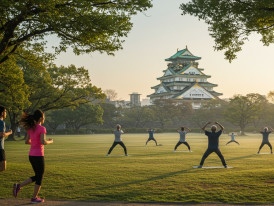
Early morning joggers and locals exercising in Osaka Castle Park with the castle visible in the distance
The Real Story Behind Osaka Castle
First, you'll probably arrive at Osaka Station or Shin Osaka Station and follow the crowds. That's fine. The castle sits in Osaka Castle Park, which is genuinely beautiful, especially if you time it right. But here's where most people get it wrong.
The castle you're looking at? It's a 1931 reconstruction, rebuilt again in the 1990s. The elevator inside should be your first clue. I'm not saying this to disappoint you; I'm saying it because understanding this changes how you experience it.
Instead of rushing to the top for the obligatory photo, spend time in Osaka Castle Park first. Early morning is best, when the joggers outnumber the tour groups. Walk the outer grounds where actual Japanese history happened. The stone foundations? Those are original, survivors of centuries of warfare and bombing.
The real magic happens when you realize Osaka Castle isn't just a building; it's the center of our city's story. This was once Japan's capital city, briefly, during the Azuchi-Momoyama period. Standing here, you're at the heart of Japanese culture and Osaka's rich history.
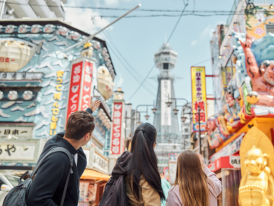
Tsutenkaku Tower rising above the bustling streets of Shinsekai district with local shops and restaurants below.
Why Most People Miss the Best Views
The truth about city views in Osaka is this: we have better options. Way better options.
The Umeda Sky Building Secret
I take first-time visitors there around sunset. You can see Osaka Bay stretching to the horizon, the bullet train lines cutting through the city like silver threads, and on clear days, the mountains that separate us from Kyoto.
Tsutenkaku Tower: Tourist Trap or Worth It?
Let's talk about Tsutenkaku Tower honestly. It's been Osaka's symbol since 1912, rebuilt in 1956, and yes, it looks like a mini Eiffel Tower. Most locals will tell you to skip it.
I disagree.
Not because the views are spectacular; they're decent but not extraordinary. Not because it's historically significant, though it is part of the city's history. I recommend Tsutenkaku Tower because it sits in Shinsekai, and Shinsekai is where you'll find Osaka that most guidebooks miss.
This neighborhood survived the atomic bomb dome era, when Japan was rebuilding itself. The streets here buzz with local life in a way that touristy areas don't. The grilled skewers (kushikatsu) here aren't just street food; they're a cultural institution. There's an unspoken rule: no double-dipping in the sauce. Break it once, and you'll understand why Osaka residents take food seriously.
Looking for a private city experience in Osaka?
Explore the city with a local who plans a private day just for you; no groups, no scripts.

The Wizarding World of Harry Potter section at Universal Studios Japan with detailed castle architecture Photo by Zhang Meng on Unsplash
The Universal Studios Japan Reality Check
Universal Studios Japan attracts millions of visitors annually. The wizarding world of Harry Potter is impressive, the Jurassic Park section is fun, and yes, the Spider-Man ride is genuinely thrilling.
But here's my local take: if you only have a few days in Osaka, spending an entire day at Universal Studios means missing what makes this city unique. Theme parks exist everywhere. Osaka's authentic bustling streets, its oldest temples, and its vibrant nightlife don't.
That said, if theme parks are your thing, or if you're traveling with kids, Universal Studios Japan delivers. The Harry Potter section is particularly well-done, and the food options are surprisingly good. Just don't let it consume your entire Osaka experience.
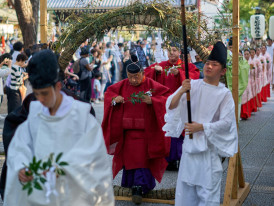
Visitors in traditional dress participating in a ceremony at Sumiyoshi Shrine with priests in white robes Photo by Buddy AN on Unsplash
Beyond the Postcard: Osaka's Actual Best Kept Secrets
I'm careful about the phrase "hidden gems" because the internet has made truly hidden places nearly impossible to find. But there are still spots in Osaka that feel like secrets, even when they're not.
Namba Yasaka Shrine: More Than Instagram Bait
Namba Yasaka Shrine gets photographed constantly because of its giant lion head structure. It looks dramatic against osaka's urban backdrop, and yes, it makes for a striking photo. But spending five minutes here for a photo and leaving means missing the point entirely.
This shrine represents something essential about Japanese culture: the way the sacred and secular coexist. You're standing in one of Osaka's busiest districts, surrounded by karaoke bars and street food vendors, but this space remains peaceful. It's a perfect metaphor for how Japan balances tradition with modernity.
Come early in the morning or late in the afternoon. Watch locals stop by to pray before work or after shopping. That's when you'll understand what makes this place special beyond its photogenic qualities.
The Sumiyoshi Shrines Complex
The Sumiyoshi shrines don't make most tourist itineraries, which is exactly why they should make yours. These are among Japan's oldest temples, predating most of the major cities you'll visit.
The architecture here represents pure Japanese design, free from Chinese influence. The curved bridges, the wooden structures, the way light filters through the trees; this is old Japan, the Japan that existed before Buddhism arrived, before foreign influence shaped our aesthetic.
I bring visitors here when they want to understand Japanese history beyond the castle reconstructions and theme park attractions. It's a short walk from central Osaka, but it feels like stepping into a different century.

Business people lining up at a small local restaurant during lunch hour with simple, authentic decor Photo by Amos Lee on Unsplash
Food Tours vs. Real Food Culture
Everyone wants to do a food tour in Osaka. We're known for our street food, our takoyaki, our okonomiyaki. Tourism websites will sell you detailed itinerary packages promising authentic experiences.
Let me save you some money and give you better advice.
The Truth About Osaka Street Food
Kuromon Ichiba Market
The real street food culture happens in places like Kuromon Ichiba Market, but not at the stalls with English signs and photo menus. Look for the places where locals line up, where the only decoration is the smell of grilled skewers and fresh seafood.
My rule: if there's a line of people in business suits at lunch time, that's where you want to eat. Office workers know good food, and they don't have time for mediocre experiences.
What if your day in Osaka was planned by someone who knows it — and you?
City Unscripted matches you with a local host who creates a private experience based on your interests, not a set route.
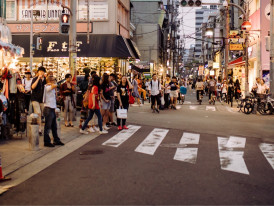
Colorful street art and youth fashion in Americamura district with young people shopping and hanging out.
The Day Trip Dilemma: Staying vs. Leaving
Osaka's location makes it perfect for day trip excursions. Kyoto is 30 minutes away. Nara is 45 minutes away. Miyajima Island is accessible by train. Kansai International Airport connects you to the rest of Japan efficiently.
But here's my perspective: everyone tries to see too much, too quickly.
When to Take a Day Trip
Kyoto's temples and traditional architecture offer experiences you won't find in modern Osaka. Nara's deer park creates memories that last a lifetime.
But don't sacrifice understanding Osaka deeply for checking items off a regional bucket list.
The Art of Slowing Down
The most satisfying visits to Osaka happen when people resist the urge to see everything. Instead of rushing between major cities, spend time in different neighborhoods here.
Explore the nostalgic charm of Hozenji Yokocho, where traditional lanterns light narrow alleys filled with tiny restaurants. Each one seats maybe eight people, and the chefs have been perfecting their recipes for decades.
Walk through Americamura (America Village) to see how Japanese youth culture absorbs and transforms foreign influences. It's not beautiful in a traditional sense, but it's authentic in a way that polished tourist areas aren't.
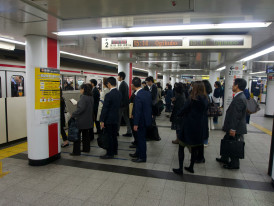
A crowded but orderly platform at Osaka Station during rush hour with commuters waiting for trains Photo by Marek Lumi on Unsplash
Transportation Reality: Getting Around Like a Local
Osaka Station and Shin-Osaka Station handle millions of passengers annually. The train stations here connect you to every major city in Japan, and the local subway system covers the entire metropolitan area efficiently.
But navigating it as a visitor requires strategy.
The Bullet Train Experience
Everyone wants to ride the bullet train. It's fast, efficient, and represents Japanese engineering at its finest. The journey from Tokyo takes about three hours, and watching the countryside blur past at 200 mph never loses its appeal.
However, most bullet train journeys end at Shin Osaka station, not Osaka station. This confuses many visitors, who assume they're in the same place. They're not. Shin-Osaka Station serves the bullet train network primarily, while Osaka Station is the larger, more central hub for local and regional trains.
Plan accordingly. Know which station your accommodations are closest to, and factor in transfer time between the two.
Local Train Strategy
The Osaka subway system is comprehensive but can be overwhelming. Here's local advice: download the Hyperdia app, learn the major line colors (Midosuji Line is red, Tanimachi Line is purple), and don't be afraid to ask station staff for help.
Most importantly, avoid rush hours (7–9 am and 5–7 pm) unless you enjoy being compressed into train cars with thousands of commuters. Outside those windows, the system is pleasant and efficient.
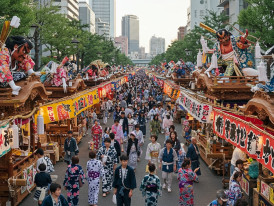
Colorful summer festival in Osaka with traditional floats, people in yukata, and festival food stalls
Seasonal Osaka: When Timing Changes Everything
Osaka transforms with the seasons in ways that affect your entire experience.
Cherry Blossom Season: Beautiful and Brutal
Cherry blossom season brings millions of visitors to Japan. Osaka Castle Park becomes a pink wonderland, and hanami (cherry blossom viewing) parties fill every green space in the city.
It's genuinely beautiful. It's also genuinely crowded.
If you visit during cherry blossom season, adjust your expectations. Popular spots will be packed. Restaurants will be busier. Hotels will be more expensive. But the trade-off is experiencing one of Japan's most celebrated natural phenomena.
For a peaceful escape during cherry blossom season, try Minoo Park. It's a short train ride from central Osaka, but most tourists don't make the journey. The cherry blossoms here are just as beautiful, and you can enjoy them without fighting crowds for viewing spots.
Summer: Heat, Festivals, and Survival
Summer in Osaka is hot and humid. Temperatures regularly exceed 35°C (95°F), and the humidity makes it feel even hotter. This isn't pleasant sightseeing weather.
But summer also brings matsuri (festivals) that showcase Japanese culture in ways no museum can match. The Tenjin Matsuri in July is one of Japan's three major festivals, featuring boat processions on the river and fireworks that light up the entire city.
If you visit in summer, plan for the heat. Start early, take midday breaks in air-conditioned spaces, and stay hydrated. The observation deck experiences are best in early morning or evening when temperatures drop slightly.
Tip
We match you with the right host, not just any guide.Want to experience the real Osaka with someone who lives there?
A fully private experience, planned and led by a local host who tailors the day to you
The Museum Question: Culture vs. Experience
Osaka has several excellent museums. The Osaka museum of history provides context for everything you're seeing around the city. The maritime museum showcases our relationship with Osaka bay and our history as a trading port.
But here's my honest take: if you only have a few days in Osaka, museums might not be your best use of time.
This isn't because they're not good; they are. It's because Osaka's culture is best experienced through direct interaction. The bustling city reveals itself through its markets, neighborhoods, and daily rhythms better than any display case.
However, if weather forces you indoors, or if you're genuinely interested in understanding the historical context of what you're experiencing, the museums provide valuable insight.
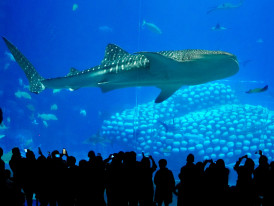
Massive main tank at Osaka Aquarium Kaiyukan with whale sharks swimming and visitors silhouetted against the blue water Photo by yao oo on Unsplash
Aquariums and Marine Life: Kaiyukan's Appeal
Osaka Aquarium Kaiyukan consistently ranks among the world's best aquariums. It's home to whale sharks, diverse marine life from the Pacific Rim, and innovative exhibits that simulate natural habitats.
This is one tourist attraction that locals genuinely appreciate. The design is thoughtful, the marine life is well-cared for, and the experience provides education alongside entertainment.
Located near Osaka Bay, it pairs well with a visit to the nearby Ferris wheel and shopping complex. It's particularly good for families or anyone interested in marine biology.
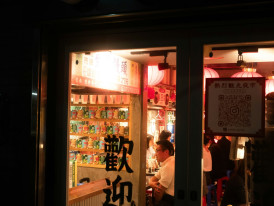
Late-night ramen shop with locals sitting at the counter enjoying bowls of noodles under warm lighting Photo by David Emrich on Unsplash
Nightlife: Beyond the Neon Lights
Osaka's nightlife extends far beyond the famous neon lights of Dotonbori, though those certainly make for impressive photos.
Karaoke Culture and Karaoke Bars
Karaoke bars in Osaka range from tiny boxes that seat four people to massive complexes with dozens of rooms. It's not just entertainment; it's social bonding, stress relief, and cultural expression rolled into one activity.
The best karaoke experiences happen with locals who can guide you through song selection and explain the unwritten rules. Don't worry about singing ability; enthusiasm matters more than skill.
Late-Night Food Culture
The real Osaka nightlife happens around food. Ramen shops open at midnight. Yakitori stalls serve grilled skewers until dawn. Convenience stores stock fresh food 24 hours a day.
This is when you'll see a different side of the bustling metropolis. Office workers unwinding after long days, students celebrating, locals meeting friends they haven't seen in months.
Ready to plan your perfect day in Osaka?
Start your experienceThe Spa World Exception
Spa World doesn't fit the typical "hidden gem" or "major attraction" categories. It's a massive hot spring complex with themed floors representing different countries, multiple pools, saunas, and relaxation areas.
It sounds gimmicky, and in many ways, it is gimmicky. But it's also genuinely relaxing and uniquely Japanese in its approach to bathing culture.
If you're curious about onsen (hot spring) culture but nervous about traditional bathhouses, the spa world provides a more accessible introduction. It's clean, modern, and less intimidating for first-time visitors.
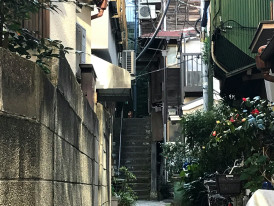
A quiet morning scene in a residential Osaka neighborhood with locals going about their daily routines Photo by YUGO ASAI on Unsplash
Creating Your Own Osaka Experience
After years of giving recommendations, I've learned that the best Osaka experiences are personal ones. The moments that stick with visitors aren't always the famous attractions or the perfectly planned itineraries.
They're the conversations with locals who help with directions, the small restaurant discovered by accident, the view from a train window during sunset, and the realization that a bustling city can also feel welcoming.
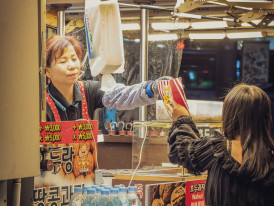
Regular locals at a traditional morning market, greeting each other and shopping for daily necessities Photo by Justin Bautista on Unsplash
What Makes Osaka Worth Multiple Visits
Most people visit Osaka once, check it off their Japan itinerary, and move on. But Osaka is a city that reveals itself slowly. The first visit shows you the surface: the castle, the food, the energy. Return visits let you understand the layers underneath.
You start recognizing neighborhoods, understanding subway line connections, and developing preferences for certain restaurants. You realize that Osaka isn't just a stop on your way to other destinations; it's a destination worth understanding on its own terms.
The city's appeal isn't just its top attractions or street food scene. It's the way it balances tradition with innovation, the way it maintains its own identity while welcoming millions of visitors, the way it manages to feel both internationally connected and distinctly Japanese.
Final Recommendations: Making the Most of Your Time
If you're planning Osaka Experiences, consider what you want from your visit. Are you looking for iconic landmarks and photo opportunities? Focus on Osaka Castle, the observation deck experiences, and the famous food districts.
Are you interested in understanding Japanese culture beyond the surface level? Spend time in the oldest temples, take a meaningful cooking class, and explore neighborhoods where tourists are rare.
Want to experience modern Japan at its most dynamic? Dive into the bustling streets of different districts, try the convenience store culture, and understand how a major city functions when millions of people live and work nearby.
For Osaka sightseeing tours, look for guides who understand that showing you places is only part of the job. The best guides help you understand context, share stories that bring locations to life, and adjust recommendations based on your interests rather than following rigid scripts.
What if your day in Osaka was planned by someone who knows it — and you?
City Unscripted matches you with a local host who creates a private experience based on your interests, not a set route.
Want to experience the real Osaka with someone who lives there?
A fully private experience, planned and led by a local host who tailors the day to you
